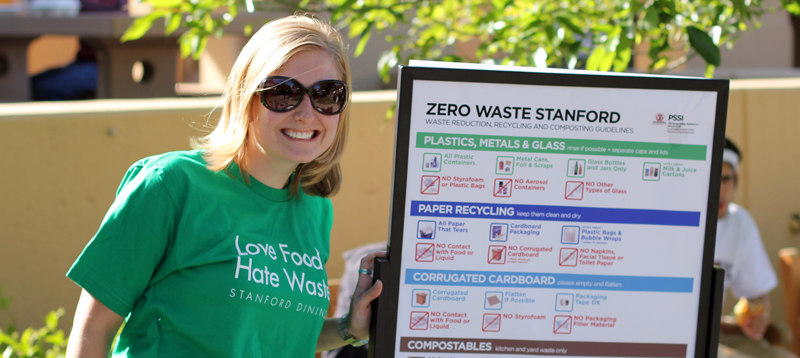Sustainability in Information Technology
From research labs to staff desks to student dorms, computers are a way of life here at Stanford. Everywhere you go on campus, you are in the midst of technology. Stanford hosts approximately 40,000 desktop and laptop computers and has roughly 6,000 servers used for administrative and research computing. All of this equipment is a significant source of energy use and greenhouse gas emissions, especially when every stage of its production and use lifecycle is accounted for, such as manufacturing, transportation, use, and disposal. In addition, computers generate heat and it often takes as much energy to cool computing equipment as it takes to run it. Approximately 15 percent of our campus electricity energy use is due to our IT infrastructure.
The Sustainable IT program began as a joint effort between the Department of Sustainability and Energy Management and Information Technology Services to address sustainability issues for both IT equipment and the facilities that house these systems. The ultimate goals are to increase the efficiency of our IT infrastructure, and to reduce greenhouse gas emissions caused by computing and IT-related activities.
Goals & Results
Making our IT Infrastructure more efficient reduces the electricity needed to run computing and telecom equipment, the cooling needed to keep facilities at the right temperature, the energy used to build the systems, the resources consumed to build-out new facilities, and the electronic waste that results from equipment disposal.
Sustainable IT at Stanford also aims to inform and educate the community on the benefits of more energy efficient computing, and to provide the tools and resources to empower others to lead their own Sustainable IT initiatives.
Desktop Computing & Office Equipment
With 40,000 desktop and laptop computers on campus, saving energy one computer at a time can have a big impact. Stanford’s desktop energy saving program includes centrally-funded desktop power management software for all faculty, staff and students, moving backups and patches from night to day, putting computers in sleep mode, and reducing peripheral energy usage by providing special pricing with smart power strips. Turning off monitors and putting computers to sleep when not in use is estimated to save the University over 2 million kWh/year in electricity usage.
For computer purchases, 100 percent of recommended computers are rated EPEAT Gold. Procurement includes Energy Star requirements in all RFPs, where available, and offers an exchange program for older printers.
Datacenters
Stanford’s primary datacenter has undergone a year-long energy efficiency retrofit resulting in a PUE of 1.4. With our new instrumentation, we have continuous PUE monitoring and automated controls to maximize outside air cooling. Additionally, we have fully utilized cold-aisle containment to reduce the amount of cooling needed and have installed variable speed drives on all our air-handling units.
10 Steps to Datacenter Energy Efficiency - PDF
Server Rooms
Stanford has dozens of smaller server rooms, which we call Satellite Server Rooms, distributed across campus. Most are run by schools and departments rather than IT Services. In an effort to understand energy use in these rooms, Stanford studied rooms with different cooling methodologies to determine their efficiency. In short, we determined that how you design and run a room can make a 2x difference in how much it costs to run it.
Satellite Server Rooms: Taming the Beast - PDF
Based on results from the Satellite Server Room study, Stanford produced a guide to designing and running server rooms, which is available to the public as the Server and Telecom Room Design Guide.
Server and Telecom Room Design Guide
Server Virtualization
Whether in a datacenter or a satellite server room, each server running on campus uses energy to keep it running, as well as to cool the room it’s in. Server virtualization allow multiple servers to operate on a single machine, dramatically reducing energy use. In addition, a virtualized environment provides better hardware utilization, flexibility and recoverability in the case of failures, as well as reduced operating costs. VMware is available for both administrative and academic computing to facilitate server virtualization.
Energy Savings Enabled by IT
IT Services provides a Work Anywhere Toolkit that allows staff to work remotely and save the greenhouse gas generated from commute trips.







